The best way to visualize the action of the engine in the animation at left is to look not at the rotor itself, but the cavity created between it and the housing. The Wankel engine is actually a variable-volume progressing-cavity system. Thus there are 3 cavities per housing, all repeating the same cycle. Note as well that points A and B on the rotor and e-shaft turn at different speeds - Point B circles 3 times as often as point A does, so that one full orbit of the rotor equates to 3 turns of the e-shaft.
As the rotor rotates and orbitally revolves, each side of the rotor is brought closer to and then away from the wall of the housing, compressing and expanding the combustion chamber like the strokes of a piston in a
reciprocating engine. The power vector of the combustion stage goes through the center of the offset lobe.
While a
four-stroke piston engine makes one combustion stroke per cylinder for every two rotations of the crankshaft (that is, one-half power stroke per crankshaft rotation per cylinder), each combustion chamber in the Wankel generates one combustion stroke per driveshaft rotation, i.e. one power stroke per rotor orbital revolution and three power strokes per rotor rotation. Thus,
power output of a Wankel engine is generally higher than that of a four-stroke piston engine of similar
engine displacement in a similar state of tune; and higher than that of a four-stroke piston engine of similar physical dimensions and weight.



 Also, as soon as mileage and age creeps in... you could be looking 10-20% reduction in power anyway due to wear and tear.
Also, as soon as mileage and age creeps in... you could be looking 10-20% reduction in power anyway due to wear and tear.
